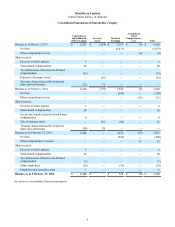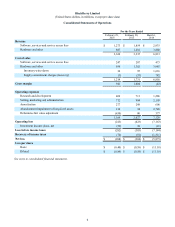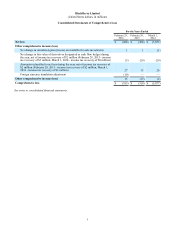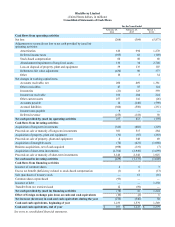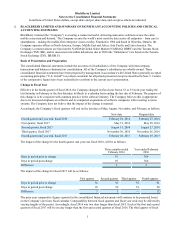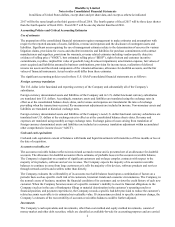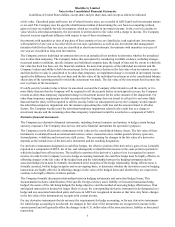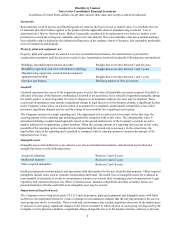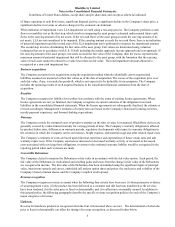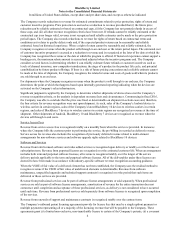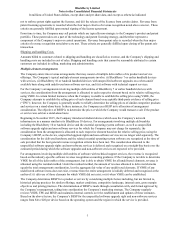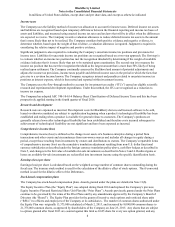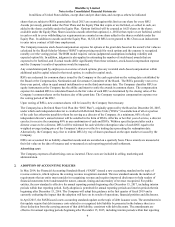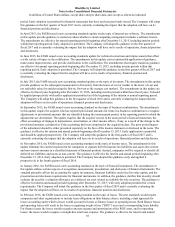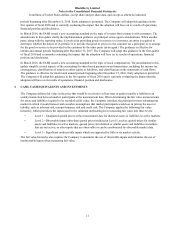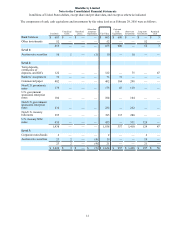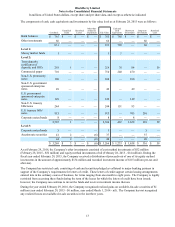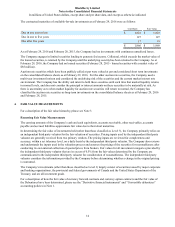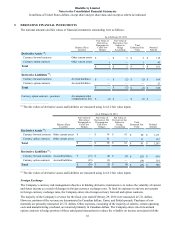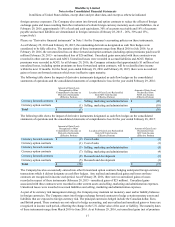Blackberry 2016 Annual Report Download - page 75
Download and view the complete annual report
Please find page 75 of the 2016 Blackberry annual report below. You can navigate through the pages in the report by either clicking on the pages listed below, or by using the keyword search tool below to find specific information within the annual report.
BlackBerry Limited
Notes to the Consolidated Financial Statements
In millions of United States dollars, except share and per share data, and except as otherwise indicated
7
not to enforce patent rights against the licensee, and (iii) the release of the licensee from certain claims. Revenue from
patent licensing agreements is recorded when the four major criteria of revenue recognition noted above are met. These
criteria are generally fulfilled upon mutual signing of the license agreement.
From time to time, the Company may sell patents which are typically non-strategic to the Company’s product and patent
portfolio. These patent sales are a part of the technology and patent licensing strategy, and therefore represent a
component of the Company’s major or central operations. Revenue from patent sales is recorded when the four major
criteria of revenue recognition noted above are met. These criteria are generally fulfilled upon closing of the patent sale
transaction.
Shipping and handling Costs
Amounts billed to customers related to shipping and handling are classified as revenue, and the Company’s shipping and
handling costs are included in cost of sales. Shipping and handling costs that cannot be reasonably attributed to certain
customers are included in selling, marketing and administration.
Multiple-element arrangements
The Company enters into revenue arrangements that may consist of multiple deliverables of its product and service
offerings. The Company’s typical multiple-element arrangements involve: (i) BlackBerry 7 or earlier handheld devices
with services, (ii) BlackBerry 10 or Android handheld devices with unspecified software upgrades on a when-and-if
available basis along with undelivered non-software services, and (iii) software with technical support services.
For the Company’s arrangements involving multiple deliverables of BlackBerry 7 or earlier handheld devices with
services, the consideration from the arrangement is allocated to each respective element based on its relative selling price,
using VSOE. In certain limited instances when the Company is unable to establish the selling price using VSOE, the
Company attempts to establish the selling price of each element based on acceptable third-party evidence of selling price
(“TPE”); however, the Company is generally unable to reliably determine the selling prices of similar competitor products
and services on a stand-alone basis. In these instances, the Company uses BESP in its allocation of arrangement
consideration. The objective of BESP is to determine the price at which the Company would transact a sale if the product
or service was sold on a stand-alone basis.
Beginning in November 2015, the Company introduced Android devices which uses the Company’s network
infrastructure in a manner similar to its BlackBerry 10 devices. For arrangements involving multiple deliverables
including the BlackBerry 10 or Android device and the essential operating system software, as well as unspecified
software upgrade rights and non-software services for which the Company may not charge for separately, the
consideration from the arrangement is allocated to each respective element based on the relative selling price, using the
Company’s BESP, as the device, unspecified upgrade rights and non-software services are no longer sold separately. The
consideration for the delivered hardware and the related essential operating system software are recognized at the time of
sale provided that the four general revenue recognition criteria have been met. The consideration allocated to the
unspecified software upgrade rights and non-software services is deferred and recognized on a straight-line basis over the
estimated period during which the software upgrades and non-software services are expected to be provided.
For arrangements involving multiple deliverables of software with technical support services, the revenue is recognized
based on the industry-specific software revenue recognition accounting guidance. If the Company is not able to determine
VSOE for all of the deliverables of the arrangement, but is able to obtain VSOE for all undelivered elements, revenue is
allocated using the residual method. Under the residual method, the amount of revenue allocated to delivered elements
equals the total arrangement consideration, less the aggregate fair value of any undelivered elements. If VSOE of any
undelivered software items does not exist, revenue from the entire arrangement is initially deferred and recognized at the
earlier of: (i) delivery of those elements for which VSOE did not exist; or (ii) when VSOE can be established.
The Company determines BESP for a product or service by considering multiple factors including, but not limited to,
historical pricing practices for similar offerings, market conditions, competitive landscape, internal costs, gross margin
objectives and pricing practices. The determination of BESP is made through consultation with, and formal approval by,
the Company’s management, taking into consideration the Company’s marketing strategy. The Company regularly
reviews VSOE, TPE and BESP, and maintains internal controls over the establishment and updates of these estimates.
Based on the above factors, the Company’s BESP for the unspecified software upgrade right and non-software services
ranges from $4 to $20 per device based on the operating system and the region in which the service is provided.


